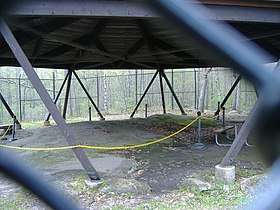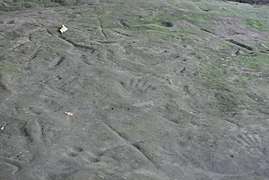Sanilac Petroglyphs Historic State Park
| Sanilac Petroglyphs Historic State Park | |
|---|---|
 The site under its protective shelter | |
 Location in Michigan | |
| Location | Lower Peninsula, Sanilac County, Michigan USA |
| Nearest town | Cass City, Michigan |
| Coordinates | 43°39′28″N 83°01′07″W / 43.65778°N 83.01861°WCoordinates: 43°39′28″N 83°01′07″W / 43.65778°N 83.01861°W |
| Area | 240 acres (97 ha) |
| Elevation | 751 feet (229 m)[1] |
| Designation | Michigan State Park |
| Established | 1971 |
| Governing body | Michigan Department of Natural Resources |
| Website | |
|
Sanilac Petroglyphs | |
| NRHP reference # | 71001024 |
| Added to NRHP | January 25, 1971 |
Sanilac Petroglyphs Historic State Park is a state park in Michigan containing Michigan's only known rock carvings attributable to Native American Indians. The park consists of 240 acres (97 ha) in Greenleaf Township, Sanilac County, in Michigan's Lower Peninsula.[2] There is concern that without preservation, the carvings may be worn further away and lost.[3] The site was added to the National Register of Historic Places in 1971.[4]
History
The carvings, known as petroglyphs, were discovered by residents after a fire swept through the area in 1881 and revealed rocks bearing the designs. Because they are made in relatively friable sandstone, geologists have been able to determine that the carvings were made 300 to 1,000 years ago, dating back to the Late Woodland Period. After going through a number of hands, a 240-acre parcel was purchased from two different owners by the Michigan Archaeological Society in 1966, with the land being deeded to the state in 1971 to secure it for educational and interpretive purposes.[5]
The petroglyphs
The petroglyphs include depictions of swirls, lines, handprints, flying birds and bow-wielding men, likely carved over many years by unknown peoples passing by the site while traveling along the nearby Cass River on a 1,000-square-foot (93 m2) sandstone rock in Sanilac County, Michigan between 300 and 1,000 years ago. The petroglyphs are the only known such carvings in the state of Michigan.
 Detail of a carved archer-like figure
Detail of a carved archer-like figure Gaps in the surface of the stone existed when the site was surveyed in the 1920s, indicating that carvings had been removed prior to that time.
Gaps in the surface of the stone existed when the site was surveyed in the 1920s, indicating that carvings had been removed prior to that time. Detail of a carved handprint
Detail of a carved handprint
Conservation and vandalism
The sandstone slab in which the petroglyphs were carved is a soft stone that allowed Native Americans to cut it easily. But that softness has proven problematic as it has allowed generations of visitors to damage the slab with graffiti. Graffiti combined with natural weathering has made the actual petrogyphs difficult for visitors to see. The state has made a series of improvements to the site to protect the slab, including a wooden pavilion erected in the mid-1990s and a chain-link fence surrounding the petroglyph site.
References
- ↑ "Sanilac Petroglyphs Historic State Park". Geographic Names Information System. United States Geological Survey.
- ↑ "Sanilac Petroglyphs Historic State Park". Michigan Department of Natural Resources. Retrieved July 12, 2018.
- ↑ Associated Press (June 21, 2005). "Michigan's American Indian carvings in danger". NBC News. Retrieved July 12, 2018.
- ↑ "Sanilac Petroglyphs". NPGallery. National Park Service. Retrieved July 12, 2018.
- ↑ "General Management Plan (Draft): Sanilac Petroglyphs Historic State Park" (PDF). Michigan Department of Natural Resources. 2011. p. 31. Retrieved July 12, 2018.
External links
| Wikimedia Commons has media related to Sanilac Petroglyphs. |
- Sanilac Petroglyphs Historic State Park Michigan Department of Natural Resources